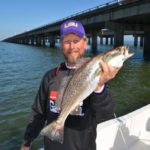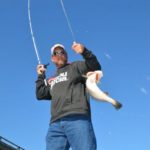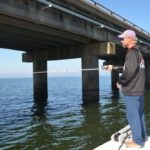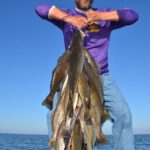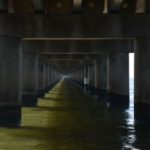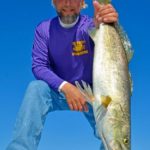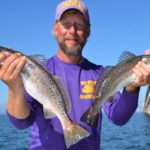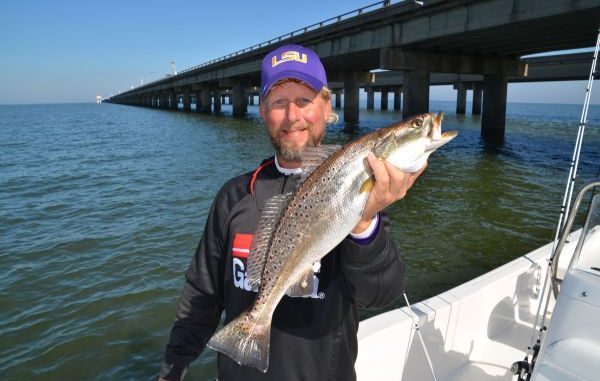
This is the month when bruiser trout show up on Lake Pontchartrain’s Causeway bridge. And this veteran captain knows just how to put them in the boat.
“Most people have never seen a 5-pound speckled trout. They call a 2 ½-pound fish 5 pounds. I know that because they do it on my boat all the time. A 5-pound trout is huge!”
The man who made that aggressive statement had a lean, hungry look — like a wolf.
Greg Schlumbrecht of To Fish Charters (985-960-1709), who is only 37 but has been guiding in Lake Pontchartrain for 15 years, said magic things can happen in Lake Pontchartrain in October.
On land, scary monsters come out for Halloween. But the big lake also has its own monsters this time of the year. These have little black specks all over their bodies and big yellow mouths with fangs in their jaws.
This is Schlumbrecht’s favorite time of the year. The old-timers who used to fish the lake called these fish “World Series trout,” because the run so often coincided with the professional baseball World Series.
Schlumbrecht talked over his shoulder as he carefully worked his soft plastic-tipped jighead around the concrete pilings that support the Lake Pontchartrain Causeway bridge.
He explained that before the Causeway bite starts he is always fishing the short bridges at the eastern end of the lake: the Tressels, the twin spans, Highway 11 and the L&N bridge in the Rigolets Pass.
“Those bridges have nice fish, but not the size of these (Causeway bridge) fish the last few years,” Schlumbrecht said. “I start checking for the fish on this bridge the first of October. I check every week.
“It’s funny. One day is nothing; the next day I catch 30, and then it’s regular until the water temperature drops to 50 degrees Fahrenheit. After that, I may catch a few during warm periods, but it’s never the same as it was before it hit 50 degrees.”
The fish are hefty.
“Lots of these fish are over 3 pounds —on a scale,” he said.
Schlumbrecht said this period has such high demand from his clients that he has a waiting list.
“Throughout the year, I put together a list of customers who want to catch these fish,” he explained. “I leave as many days free as I can in that four- to six-week window (in October and November).
“When the fish start (biting), I call them in the order that they got on the list. I already have three people on the list for next year. During the bite, customers will call me and ask what number they are on the list at that time.”
And his clientele are ready for the challenge of catching large fish.
“My business, year-round is peculiar: I take out mostly fishermen — not many novices,” Schlumbrecht said. “Probably 80 percent of my customers own their own bay boat. They go with me for a chance to catch a big trout.”
The bite on the bridge last year was in mid-lake, so it was a 12-mile run from the Pontchartrain Yacht Club Mandeville Harbor.
The long morning run was cool, even though Schlumbrecht didn’t launch early.
Once the weather begins to chill, he explained, he likes to get on the water later and later. By early December, he doesn’t start fishing until 10 a.m.
The later start brings another benefit.
“You avoid the rush-hour traffic on the bridge,” he said with a bit of a grimace.
It is hard to describe how noisy fishing under the bridge is as vehicles clackity-clack and thumpity-thump directly overhead.
Fishing the Causeway is not a wilderness experience: You have to have a high tolerance for noise.
The morning started off nippy. Schlumbrecht wore a black hoodie over his trademark purple-and-gold fishing shirt.
From his perch on the bow deck, he flipped his lure as close to each pole as possible.
“I try to get it a millimeter from the pole,” Schlumbrecht said.
When the lure hit the water, he stood stock still with his rod pointing at the pole and the reel unengaged.
“Don’t engage the reel,” he lectured. “That’s the first mistake that people make. If you do, instead of the bait dropping straight down, it pendulum swings away from the pole.”
After the bait hit bottom, the guide engaged the reel and gave the lure sharp vertical jigs without following each jig with a horizontal pull.
In other words, he tried to keep the bait as close to the pole as long as possible.
“I am only fishing about 2 feet away from each pole before retrieving the bait,” Schlumbrecht explained.
He used different movements to determine “how they want it today.” Sometimes he gave sharp pops, sometimes wiggles, sometimes he would simply pick the lure up and lay it down.
He even did dead-stick — no movement at all.
No matter what movement he used, however, he never lost contact with the lure.
“The second mistake that people make is that they let the line go slack on the drop,” Schlumbrecht explained. “A large percentage of bites come on the drop, and they don’t feel those.”
Maybe it was the cooler temperatures behind the front or whatever, but the fish were not cooperating.
Schlumbrecht had been fishing for an hour and hadn’t boated a speck yet.
He wasn’t perturbed, though.
“A big problem people have is losing confidence too quickly,” he said, probably to buck up my courage more than anything. “You may make 200 casts before catching a fish. I may crank up the boat and move 100 yards once or twice, but that’s more to satisfy my attention deficit disorder than anything else.
“It’s hard for some customers; they may have to fish 45 minutes or an hour without a fish at first. They kind of look at you ….”
He threw a baleful eye at me as a demo.
The key is to be fishing when the trout turn on.
“At this time of year, the fish are there,” Schlumbrecht promised. “They will feed at some time of the day.”
He cited a trip made the previous week when they had only eight fish at noon but nailed 47 by 3 p.m.
And the timing of the bite isn’t a tide thing, the lithe guide explained.
“The tide can be going either way. It can be any range,” Schlumbrecht said. “Sometimes even with no tide the water is moving because of wind blowing across the lake.”
Cast after cast lightly kissed the targeted poles, but never bounced off of them. Sometimes he threw next to the second pole in a pair, worked it and then retrieved the lure enough to be alongside the nearer pole, effectively getting two poles with one cast.
Finally, at 11:25 he caught a modest 16-incher.
“Nothing to talk about,” Schlumbrecht muttered.
But that catch broke the tension. He had been putting a lot of pressure on himself.
“I’d love to know where these fish go in the summertime,” he mused as he fished. “I don’t believe they go to Lake Borgne. The fish we catch there don’t look like these.
Then the pace picked up — a lot. He stripped down to his fishing shirt and went to work.
A lot of the trout were in the 2-pound range. A few were smaller — but nothing even close to having to be measured.
Mixed in were a good number of 4- and 5-pound fish.
“Lake Pontchartrain is one of the three best spots in Louisiana to catch a 5-pound fish,” Schlumbrecht said between casts. “I think that trout are thicker and fatter here than other places.
“Most places, they are long and skinny.”
It was almost comical to watch him when he missed a strike. He flailed the air with his rod, and then dropped his head. His shoulders drooped noticeably — the perfect picture of dejection.
But that didn’t last long. He quickly whipped out another underhanded cast and his fierce focus was back on.
The bridge traffic was still as noisy as it was earlier, but Schlumbrecht ignored it.
“I don’t even hear it,” he said. “If you hear the noise, you aren’t focused. I transfer all my attention to the bait.”
By 1:30 p.m., he was hammering their lights out.
Still, he took every missed fish personally. One particularly good fish left him spluttering oaths.
He turned and grinned sheepishly.
“If I can’t give them a piece of my hook, I can at least give them a piece of my mind,” he chuckled.
By 2:30 p.m., he was finished.
Under bright blue skies, the boat drifted away from the bridge as Schlumbrecht put up his tackle.
His lean body quivered slightly, like a horse after a good race.
“Since Hurricane Katrina, fishing pressure in this lake has tripled,” he said. “And the closing of (Mississippi River Gulf Outlet) and the creation of the Great Wall of Chalmette, the number of smaller fish has increased. We used to never have a throwback. I never carried a measuring stick.
“But the lake is still good. You don’t have to change your techniques to target trophy fish. There are just more big fish here. I believe that any cast in the lake at this time of the year could produce the next state record. I really do.”
